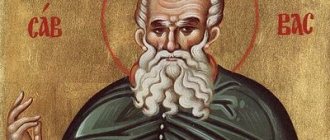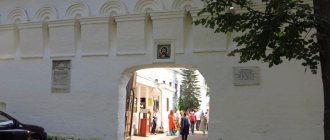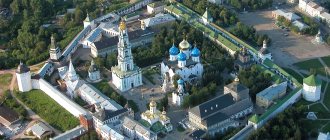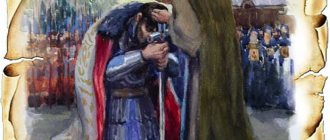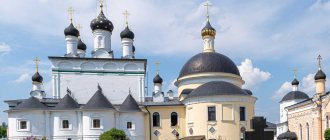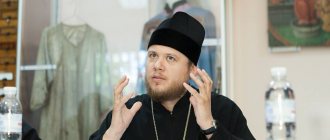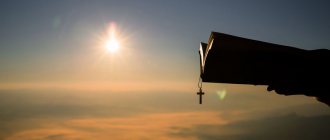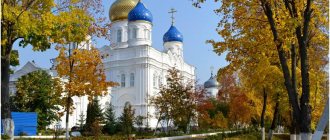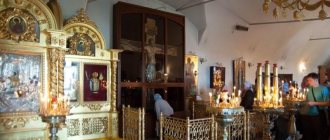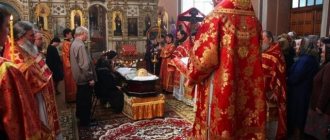"Save me, God!".
Thank you for visiting our website, before you start studying the information, please subscribe to our Orthodox community on Instagram, Lord, Save and Preserve † - https://www.instagram.com/spasi.gospodi/. The community has more than 60,000 subscribers. There are many of us like-minded people and we are growing quickly, we post prayers, sayings of saints, prayer requests, and timely post useful information about holidays and Orthodox events... Subscribe. Guardian Angel to you!
Saint Savva of Storozhevsky is one of the most revered monks in Rus'. His deeds, which were confirmed by faith, will forever remain in the souls of laymen and monks. After all, thanks to them, the Reverend was canonized as a Saint. Not so long ago, in 2007, the 600th anniversary of his tenure in this honorary, divine status was celebrated. Even during his lifetime, Savva was considered the very first and favorite student of St. Sergius of Radonezh.
Life of St. Savva of Storozhevsky
Presumably the monk was the son of a boyar family from the Principality of Smolensk. Unfortunately, these are just guesses, since there is no reliable information. The exact date of his birth is also unknown.
What is known is that from his youth he was a very pious boy, from childhood he fell in love with God and prayer, and lived in the Trinity Monastery under the supervision of St. Sergius. Later, the monk was elected confessor of the Trinity brethren. After the death of Radonezh, Savva became the abbot of the Trinity Church. This was in 1392.
In 1390, the monk blessed the construction of the Monastery of the Nativity of the Virgin Mary on Mount Storozhi, which is located in the village of Zvenigorod. This monastery was patronized by Prince Yuri Dmitrievich himself.
The saint more than once blessed Yuri on campaigns into the territory of the Horde (Volga Bulgaria, Dzhuke-Tau, Kazan, etc.). Most of these campaigns ended in glorious victory. Even later, the elder’s blessing helped save Muscovite Rus', which was threatened with complete destruction from the invasion of Tamerlane.
Monastery of Savva Storozhevsky in Zvenigorod
Construction of the monastery was completed by 1405. Several churches were erected on the territory of this holy place. The monk invited the famous artist Andrei Rublev to paint them, who, with the blessing of the priest, became the author of the Zvenigorod (Old Moscow) rite. The influence of the monk on the young artist was very great.
They say that he inspired the talented author to write the famous “Trinity” and “Savior of Zvenigorod”. The saint turned the monastery into a magnificent place of that time, where all believing peasants tried to get to.
The best article for you, go to: Icon of Equal-to-the-Apostles Princess Olga, meaning and what it helps with
The monk received everyone. He listened to people's sorrows and gave advice. He always acted as his parent, Sergius of Radonezh, taught him. Throughout his long life, the monk did not turn his back on anyone. He only humbly prayed and directed people along the path of God.
In 1407 the old man died. Before his death, he was very sick. Three days before his death, the monk gathered the Trinity brethren and told about all his righteous deeds. After his death, the descendants of Yuri and Vasily began a war for the throne. The Zvenigorod Monastery fell into decay. And the memory of the holy spring of Savva Storozhevsky was erased from memory by the hated relatives of Yuri, since he was his mentor.
Three water sources of the Trinity-Sergius Lavra
In the Trinity-Sergius Lavra and its immediate surroundings there are three springs, the water of which has long been considered healing by believers. The Pyatnitsky well, according to one version, was created by Sergius of Radonezh himself, the Assumption Key is associated with a miracle that occurred during the renovation of the cathedral, and the third revered spring may have been dug by Saint Sava of Zvenigorod.
Pyatnitsky well
If you look closely, you can see an interesting icon above the entrance to the Nadkladeznaya Chapel of the Trinity-Sergius Lavra. It depicts two monks standing near a rock from which a stream of water flows. This plot is described in the life of St. Sergius of Radonezh, compiled by his disciple Epiphanius. From the very beginning, Sergius settled in a place where there was no suitable source of water nearby. When the hermit lived alone, he carried water for himself from somewhere far away. After many followers gathered around the saint, they, according to Epiphanius, began to accuse their teacher of having thoughtlessly built the monastery too far from the spring.
Upset by the reproaches, Sergius left the monastery, taking one of the monks with him, and “went into the depths of the forest near the monastery, where there was no running water, as the old people definitely said. I found some water left after the rain in one ditch, and, kneeling down, began to pray.” After Sergius’ prayer, a spring emerged from the ground, which, according to the author of the life, began not only to be used for the needs of the monks, but began to be revered in the area as a healing spring. This well was named after Sergius during the life of the saint, but he himself forbade calling it that and said: “So that I never hear that you call this source by my name. After all, it was not I who gave this water, but the Lord gave it to us, the unworthy.”
It is not known exactly where the source that appeared through Sergius’ prayer came from. Most often it is identified with the Pyatnitsky well, which is located outside the walls of the Lavra in a beautiful white chapel on the other side of the Red Army Avenue from the monastery. There, even today you can get holy water, which flows from taps inserted into a decorative cross. This source is called Pyatnitsky after the Church of St. Paraskeva, which is located on the other side of the road. Saint Paraskeva is a Christian martyr, her name translated from Greek means “Friday”. On the fifth day of the week, Jesus Christ was crucified on the cross, so Friday was considered a sacred day among Christians. Church historian E. Golubinsky believed that the true source of Sergius, described in the life, most likely closed and disappeared without a trace. The Pyatnitsky well, according to Golubinsky, was dug much later for the needs of the Pyatnitsky Church and the almshouse that existed in these places.
Despite the historian’s doubts, the rumor that the source at the Pyatnitsky Gate is the legendary key that appeared through the prayer of Sergius has existed for centuries. In the seventeenth century, the ancient life of Sergius was supplemented with a list of miracles of the Radonezh righteous man. Among them, the case of healing of governor Dmitry Kaisa, who suffered from a serious leg disease, is mentioned. “After the prayer service, Demetrius was taken to a source that had emerged through the prayers of the saint; he plunged both legs into the water up to the knee and, thus, through the prayers of the saint, he was healed, as if he had not suffered from anything.”
Uspensky well
The spring, flowing inside the red chapel with carved columns, is today the most popular among pilgrims and tourists. This is not surprising, because it is located on the territory of the monastery in close proximity to the Assumption Cathedral. The source has never been identified with the legendary spring of Sergius, since it has its own well-known history. In the seventeenth century, monks carried out renovations on the southwestern corner of the Assumption Cathedral. Golubinsky writes: “When they dug a ditch for the foundation of the bull, spring water suddenly appeared in the ditch. One monk of the monastery received healing from the water of the spring that appeared, and one servant of the monastery, who expressed disbelief in the healing power of the water, suffered death.” The monk in question is believed to have been cured of his blindness. Miracles from the water of the spring occurred later, so very soon a stone chapel was built over it, which received the name Nadkladeznaya.
Opposite the chapel, above the Assumption well, there is also a canopy with a cast-iron bowl and a cross, from which you can also take water in the summer. A water basin was installed on this site at the end of the nineteenth century in order to supply water from the monastery water supply. During the years of the monastery's closure, the elegant canopy was dismantled; it was restored only after the Lavra was returned to the believers.
Savva Storozhevsky's spring and the spring at the Kelarsky pond
On the northern side of the monastery, not far from the Kalichya Tower, there is a descent down the stairs to the source, which, according to legend, was dug by Saint Savva of Storozhevsky. The first mention of the well of St. Sava is found in the documents of the monastery in 1641. Saint Sava lived long before this and was a student of Sergius of Radonezh. After the death of his teacher, for some time he even took the place of abbot of the Trinity-Sergius Monastery. However, he became famous as the founder of another famous monastery near Moscow in Zvenigorod, where he was invited by one of the sons of Dmitry Donskoy, Prince Yuri. By the way, Yuri Zvenigorodsky built the Trinity Cathedral with his own money - the oldest church of the Lavra, where the tomb of Sergius of Radonezh is located. Unlike the Pyatnitsky and Uspensky wells, in the Sava spring you can not only get water that comes out of a pipe on the slope of the ravine, but also take a dip in a specially equipped font. A wooden frame is placed above the font, inside which, both in winter and summer, believers are immersed in a kind of “ice hole” with cold water.
The spring of St. Sava is located in natural ravines that surround the monastery walls and towers. The Konchura River, flowing from the southern side, as well as the smaller streams flowing near the monastery, were never suitable for drinking. Otherwise, it would be difficult to explain why Saint Sergius needed to pray for finding a spring. For some time there was a folk legend that, through Sergius’ prayer, not just a spring flowed, as described in the life, but the Konchura River miraculously appeared.
The attitude of Christians towards rivers and other water sources has always been special. From the Bible we know that Jesus Christ began his preaching after the water rite of immersion in the Jordan River, which was performed by the hermit John, nicknamed the Baptist. In the Orthodox Church this event is celebrated on January 19. These days, water is blessed everywhere in temples, and at reservoirs it is customary to make “Jordan” ice holes for immersion. In several church parishes located near the Trinity-Sergius Lavra, a tradition has developed of making a procession of the cross on the day of the Epiphany holiday to the Kelarsky pond. On the southern side of the pond, the Nikolsky spring flows, which, although not directly connected with the Lavra, can be considered the fourth spring in the center of Sergiev Posad.
Miracles that were performed by the Zvenigorod saint
Due to the war for the throne, information about the monk was erased from history. Savva was known only as a local saint. In the middle of the 26th century, the abbot was canonized. And a century later, the sacred relics of the saint were found in the Zvenigorod monastery.
Ruler Alexei Mikhailovich Romanov claimed that the image of Storozhevsky saved him from the clutches of an angry bear. From that time on, the king considered him his personal intercessor.
Another remarkable incident involving the Zvenigorod abbot happened in 1812. The image of Storozhevsky appeared to Eugene Beauharnais, the military leader of the French army under the command of Napoleon. The saint asked the commander not to cause trouble to the monastery walls of Zvenigorod and its inhabitants.
This way he will remain intact in the war that France will lose. When the abbot's prediction came true, the Zvenigorod Monastery regained its former popularity.
But the miraculous effects of Savva Storozhevsky’s prayer did not end there. Since 1998, the miraculous relics of the saint were transferred to the Zvenigorod Monastery. This was due to communist rule, which prohibited monastic and church activities.
The best article for you, go to: St. Jacob of Zheleznoborovsky
Hermitage of Savva Storozhevsky
For prayerful communication with the Lord, the Reverend loved to leave the monastery. It was established that he went into a deep ravine, which was located a mile from the church. The monk dug a cave for himself on the side of a mountain, not far from a dense forest. In this cave he indulged in tearful prayers. Here he contemplated the highest abodes of heaven and earth. This place has been preserved for centuries in memory of the saint.
In 1870, a church was built above this monastery, which was named in honor of Savva Storozhevsky. Soon, an ensemble of the monastery monastery was erected near the church.
The legend says that not far from the monastery of the Zvenigorod monk there is a healing spring (spring). They say that he was caused by the prayer of Savva of Zvenigorod. This spring flows from the depths of the earth.
In order to get to this source you need to head along the walls of the Duck Tower to the Bell Tower. When you reach the stream, you need to cross the bridge and follow the signs along the dirt path. At the site of the source there is a wooden chapel and the font of Savva Storozhevsky.
They say that this healing font works incredible miracles. In order to heal your soul and body, you only need to plunge into it. But many argue that it only affects true believers. The source helps only those who are adamant in their faith and carry it in their hearts
Savvino-Storozhevsky stauropegial monastery in Zvenigorod
Cathedral of the Nativity of the Virgin Mary
The cathedral is one of the oldest surviving temples on Moscow soil (1404-1405) Photo: Yuri MOROZOV, lori.ru
White stone church in the center of Cathedral Square. Inside, on the walls there are fragments of frescoes painted by students of Andrei Rublev. Pay attention to the huge iconostasis: it was made by craftsmen commissioned by Tsar Alexei Mikhailovich.
Belfry
The asymmetrical belfry of the monastery was built in the 1650s. Photo: Natalya VOLKOVA, lori.ru
The tallest building of the monastery. Several tiers of the belfry make it asymmetrical. Cellars, a church in honor of Sergius of Radonezh, a staircase that leads to the bells. You can get here with excursions, which are collected on site.
The Royal Chambers of Alexei Mikhailovich
The construction of the Royal Chambers took several decades due to the difficult terrain and the size of the building. Photo: Mikhail KULIKOV, lori.ru
A white building with a gray roof 100 meters long. Each member of the royal family had a separate room here. Initially, the chambers were one-story; a second floor was added later. Now the building houses a library, theological classes, and monastery shops.
Palace of the Empress, wife of Alexei Mikhailovich
Until 1828, the Empress's Palace had a wooden second floor. Photo: Natalya SIDOROVA, lori.ru
It stands opposite the royal chambers, built specifically for Maria Ilyinichna Miloslavskaya. Several rooms are connected to each other. Now they have museums displaying furniture, dishes, and decorations of that time. Pay attention to the tiled stoves.
Fortress wall
The total length of the fortress wall is 760 meters. Photo: Mikhail KULIKOV, lori.ru
The wall and the towers that adjoin it were built not only by Moscow craftsmen; specialists were invited from Suzdal, Vladimir, Kostroma and other cities. Construction took four years. The total length of the fortress wall is 760 meters. Tourists can walk along it, look at the monastery from above and look into the loopholes.
Provisions Tower
Once upon a time, kings ate here, but now entry is open to all tourists. Photo: Anastasia IVANOVA, lori.ru
On its first floor there is a shop with fresh monastery pastries and sweets. Go up the stairs to the second floor, there are tables where you can have a snack. Once upon a time, kings ate here, but now entry is open to all tourists. From here there is access to the fortress wall.
Assumption Cathedral on Gorodok
Although the Assumption Cathedral does not belong to the main ensemble of the monastery, it is worth a visit to see the preserved frescoes of the 14th century. Photo: Nikolay GOLIKOV, lori.ru
It does not belong to the monastery, but is within walking distance from it. When you arrive in Zvenigorod, be sure to check it out. Icons and frescoes from the late 14th century have been preserved inside. Some of them are attributed to the brushes of Andrei Rublev. Scientists have not come to a consensus: these are the works of a famous icon painter or his students.
Saint Sava of Storozhevsky - what helps
People turn to the Reverend Monk from all over Russia and other CIS countries.
- People pray to him without even knowing what he helps with;
- They tell him about their problems, and they feel better;
- The saint helps everyone with his invisible hand;
- He guides lost souls to God;
- The saint will definitely answer a righteous, sincere prayer.
A particularly strong prayer to the Venerable on December 16th. On this saint's day they ask:
- about righteousness;
- about strengthening faith;
- about healing yourself or loved ones;
- about health;
- about integrity.
Icon of Savva Storozhevsky
The icon of the Zvenigorod abbot is made in a fairly simple style. Its basis is based on the exploits of the monk and his service to Christ and the Mother of God. Even on the icon, Savva Storozhevsky carries the word of God to please the Lord Jesus Christ.
In this icon he is depicted in monastic robes. Over the robe is a black robe. This mantle is unfolded and somewhat resembles angel wings. The color of the robe is black. It symbolizes the perfection of renunciation of the vain world, peace and renunciation of passions.
The best article for you, go to: Rules for storing icons painted on a wooden base.
The face of the Saint is turned towards the praying person. In this way, a believer is better attuned to spiritual, internal dialogue, both with the saint and with the Lord.
Text of the Orthodox prayer to Savva Storozhevsky:
O most honorable and sacred head! Citizen of heavenly Jerusalem, abode of the Most Holy Trinity, Reverend Father Savvo! Having great boldness towards the All-Merciful Master, pray for the flock of your fence and for all your children in spirit. Do not remain silent when you cry to the Lord for us and do not despise those who honor you with faith and love. By your intercession, ask the King of those who reign for the peace of the Church, under the sign of the militant cross, for the bishop's splendor, for the good monastics in their labors; protection of this holy monastery, this city and all cities and countries; serenity and peace to the world, deliverance from famine and destruction; comfort and reinforcement for the old and weak, good growth in faith for the young and infants, solid training in the Gospel teaching, and abiding in purity and chastity; mercy and intercession to widows and orphans, joy and return to the captives, healing to those who are sick, peace to the faint-hearted, correction to those who have gone astray, those who sin with a spirit of contrition, those in need, and to all who require grace-filled help, timely help. Do not disgrace us, who come to you with faith, make haste, like a loving father to your children, for us to bear the yoke of Christ in complacency and patience, and guide us all in peace and repentance, to end our lives shamelessly and settle down with hope in the heavenly abode. Where you, through your labors and struggles, are now living with the Angels and Saints, in vain and glorifying God, glorified in the Trinity, the Father and the Son and the Holy Spirit. Amen.
The Lord is always with you!
Watch a video about the life of St. Savva of Storozhevsky:
Shrines of the monastery
Since the 90s of the last century, the Church of the Nativity of the Blessed Virgin Mary has kept the relics of Savva Storozhevsky, the first abbot of the Zvenigorod monastery.
Reliquary with the relics of St. Savva in the Savvino-Storozhevsky Monastery
The temple contains particles of the relics of Seraphim of Sarov, Matrona of Moscow, St. Philaret, and Maxim the Greek. You can also see the especially revered icons of Savva Storozhevsky and Sergius of Radonezh.
In a special icon case of the temple, particles of the stone of the Holy Sepulcher and stone from Mount Golgotha are stored.
